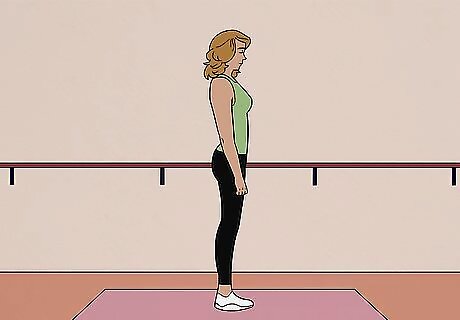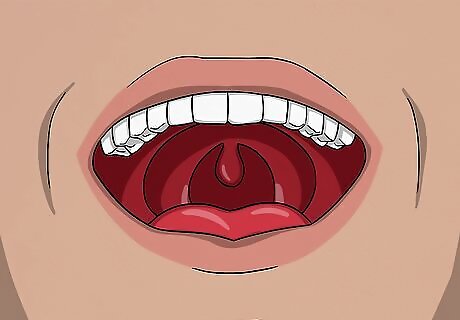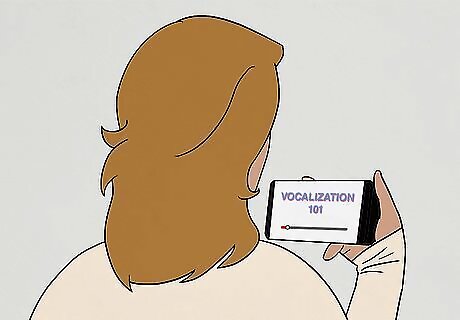
views
Breathing and Standing Correctly

Learn to breathe properly. Breathing correctly is imperative to having a strong voice. The key is to breathe deeply: As you inhale and exhale, try to inflate your stomach and kidney (back) areas with your breath. To ensure that you’re breathing into these areas, place your hands around your waist, with your thumbs on your back, your fingers at your front, and your palms resting on your sides down towards your hips. You should feel your hands expand and contract with each breath. Over time, as you strengthen your breath, these expansions and contractions will get bigger and longer. If you have trouble breathing deeply, try lying on the floor on your back, with your hands on your stomach. When you inhale, your hands should rise; when you exhale, your hands should lower. You can even place a book on your stomach and make it rise up as you inhale and lower when you exhale. Try hissing as you exhale to force the air out. Note that your shoulders should not be moving up and down with your breath.

Engage your abs. When you’re breathing correctly, when you inhale, the lower muscles (diaphragm) over your abdomen should move outward, making room for more air. As you sing (or talk or just exhale), use those muscles to push the air back out. Use the muscles over your lower back (around your kidneys) in exactly the same way to control your inhalations and exhalations. Avoid hunching over as you contract your abs.

Use the correct posture. Pay attention to the position of your feet, knees, hips, abdomen, chest, shoulders, arms, and head: Stand with your feet slightly apart and put one foot slightly in front of the other so that your weight is slightly forward. Relax your knees and keep them slightly bent. When aiming for good posture it can be tempting to lock your knees; be careful not to do this. Relax your hands and let them hang at your sides. Keep your abdomen relaxed but ready to be engaged. To get a sense of how an engaged abdomen feels, place your hands on your waist (with your thumbs on your back) and cough very lightly. Slide your shoulders back and down so that your back is straight, and your head is high. Do not hunch or pull your shoulders up towards your ears. Keep your chest slightly up and out— this will likely happen naturally when you pull your shoulders back and down. Make sure your chin is parallel with the floor — neither lifted or pointed downward.

Relax. Once you’ve moved into the correct posture, check in to make sure that you are not holding tension anywhere. It should not feel as though you’re forcing your chest out or your back to be straight. Be sure to relax your face and your neck. Singing or speaking while your body and face are tensed will only make it more difficult to produce a high-quality sound. If you are tense when standing with the correct posture, try laying on your back to let gravity do the work for you. Or, stand against a wall so the back of your head and shoulders touch the wall. This can help you feel how you should position your body, which you can them implement while standing away from the wall.
Having the Correct Mouth Position

Have an open but relaxed mouth. Your mouth should be wide open when you sing, but avoid the temptation to open it so wide that your face and neck muscles tense up. Check in to make sure that your lips, jaw, and neck feel loose and relaxed.

Lift your soft palate. A common piece of advice from professional singers is to create space in your mouth. Opening your mouth wide is part of how you can do this; another part of creating space involves dropping your jaw and tongue, and lifting your soft palate (the ridged flesh at the roof of your mouth). To do this, breathe in as you would before yawning, but try not to yawn. Pay attention to the space this creates in your mouth, including the open feeling at the back of your throat. You want to replicate this wide-mouthed, soft-jawed/lifted palate position when singing. If you do yawn, simply maintain the open position of your mouth afterward.

Ensure your tongue is positioned correctly. When creating space in your mouth, make sure that your tongue is out of the way. Let it rest softly at the bottom of your mouth, with its tip touching the back of your lower teeth. Try not to stick your tongue out or wave it around while you’re singing, as this will impair the quality of your voice, and could reduce the richness of your tone.

Remember to swallow. Too much saliva in your mouth might make it difficult to sing, so remember to swallow whenever you need to.
Using Vocal Exercises to Strengthen Your Voice

Warm up. Before singing or doing more demanding vocal exercises, you’ll benefit from doing some of the following simple exercises to warm up your voice: Yawn. Yawning will help stretch and open your mouth and throat and can help release tension in your neck and diaphragm. To trigger a yawn, try opening your mouth wide and breathing in. Sigh out the air at the end of the yawn in your singing voice in a descending line. You can even practice high notes this way. Cough very gently. Think of it as lightly pushing air out from the back of your throat in short bursts. This will help you engage your lower chest and abdominal muscles, which are the muscles you should use while singing (as opposed to your throat/upper chest).

Do lip trills and hum. Hold your lips lightly together and blow air out of them while humming, like you're making a raspberry. Focus on having a relaxed throat and an engaged core while you do this. Practice lip trills going from a low to a high note and vice versa. Once you’re used to the lip trills, practice doing scales with them. To help your body learn to relax while you sing, tense up your body and then right after releasing the tension, do a lip roll from low to high; repeat, this time going high to low. Humming is another gentle way to warm up your voice. Try humming along with music on your way to school or work or, if you’d prefer not to do that sort of thing in public, hum while you cook or while you’re in the shower.

Sing scales. Starting as low as you can comfortably sing, gently move up the scale using a “me” sound until you reach the highest note at which you are comfortable. Then, move down the scale from high to low using an “e” sound. You can also practice "woo" scales. Your mouth should look as though you’re sucking in a long string of spaghetti as you inhale. When you exhale, make a “woo” sound. It should sound buzzy, similar to the sound made by a kazoo. Keep the sound steady as you exhale; do this 2 to 3 times. Next, go up and down your scales using the “woo” sound.

Practice smooth projection with words and phrases. Say groups of single words or entire phrases without stopping between the words — treat them as a single word. Lengthen the vowels and exaggerate the vocalization of each word as you say and/or sing it. As you speak/sing, imagine that you’re filling a room with your voice. Focus on smooth transitions: when switching between higher and lower, and louder and softer parts of a song, imagine moving up and down a ramp — not a staircase. Example words: moon moan mourn mane mean. Example phrase: many men munch many melons.

Be prepared to feel silly. A lot of vocal exercises can sound and look pretty funny. Relax and have fun with it. Two fun and silly exercises that help open up your throat: Sing “meow” slowly, emphasizing its three sounds — mee, ahh, and ooo. Make weird faces by stretching out your tongue in all directions. You can do this while singing or even just making weird noises.

Cool down. As with physical exercise, cooling down after doing vocal exercises is important. One way to cool down is to do the same simple vocal warm-ups you started with (for example, yawning, light coughing, rolling your lips, and humming). Another way to cool down is simply to gently glide up and down, and down and up, on the sound “m”, so that you feel a tickling vibration in your lip/nose area.

Remember to breathe and stay relaxed. Whether you're warming up, singing, or giving a speech, breathing deeply and keeping your body, throat, and face relaxed are key to ensuring a high-quality voice.

Practice wisely on a regular basis. If you really want to improve your voice, you need to practice often. Sing with intention and try to improve specific things, such as working on your vocal range or nailing a difficult note in your favorite song. Aim to sing for 30 minutes at a time, then take a 30-minute vocal rest. During the vocal rest, don't sing, talk, whisper, or otherwise use your voice.
Making Lifestyle Changes for a Healthy Voice

Drink enough water. Drink at least six to eight 8-ounce glasses of water each day — more if you exercise or live somewhere hot (i.e. if you sweat a lot).

Eat for a healthy voice. Whole grains, fruits, and vegetables promote a healthy voice by keeping the mucus membranes that line your throat healthy.

Avoid substances that can irritate your vocal folds. These include smoke (even second-hand smoke), spicy foods, milk products, foods with a high salt content (e.g., bacon or salted nuts), citrus fruits, alcohol (including mouthwashes that contain alcohol), and cold and allergy medications.

Get enough sleep. If your body is fatigued, it will show in your voice. Adults should aim for 7 to 9 hours of sleep each night; teenagers should aim for 8.5 to 9.5 hours each night. If you get at least 7.5 hours of sleep each night and do not wake up feeling refreshed, see your doctor to ensure that there are no underlying reasons for this.

Relax. Stress affects everything negatively. Take time every day to do something that helps you relax. Relaxing activities include yoga, meditation, walking, watching a show you love, reading a good book, or playing an instrument.

Avoid shouting. This is particularly important if you have a performance coming up. Shouting can strain your voice and diminish its quality for even a few days after.

Be patient. It could take some time to improve the quality of your voice. You won’t see enormous overnight results, but you likely will feel some difference almost immediately after combining proper breathing and posture with some simple warmups. It’s okay to take it slow. Start with learning how to breathe more deeply and stand correctly. Once you’re comfortable with that, work on your mouth position and some simple warm-ups.

See a doctor if you think health problems are affecting your voice. If the quality of your voice has recently diminished — for example, become raspy, deeper, or strained — it may be a sign that you are experiencing a health issue. To be on the safe side, see a doctor to rule out potential health issues.
Learning from Others

Find a good, professional teacher. A good teacher can give you detailed feedback and advice on how to improve your voice. Aim for someone with classical training, as a classically-trained teacher is likely to have experience with a variety of styles.

Listen closely to professional singers and speakers. Listen to the way they handle their breath, volume, articulation, control, vocal habits, and resonance. If you’re particularly fond of their style, see if you can replicate it. Replicating someone’s style is a great way of learning to sing, because it forces you to try things you might not normally try when singing.

Watch professional singers and speakers. Pay attention to how they breathe and support the notes with their breath. Note their posture and body language. Watch the way they use their lips to shape the sounds and words that they are singing.

Don’t ignore professionals you dislike. Think about why you dislike a certain singer or speaker. What do they do differently from the ones you like? Are they doing something wrong or is it just not your style?

Compare the way an artist sounds in a live performance to their recordings. It is amazing what a good sound engineer can accomplish during a recording session. If you really like an artist's recordings, try to figure out how much is real and how much is engineered before you decide that "you can never sound as good as that!"

Go to open mics and other local music events. Ask those whose voice you like what they are doing to get that sound. Most will be flattered and pleased to share this information with you.



















Comments
0 comment